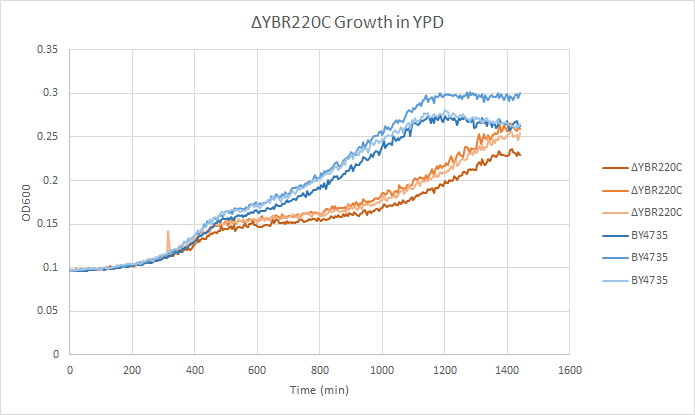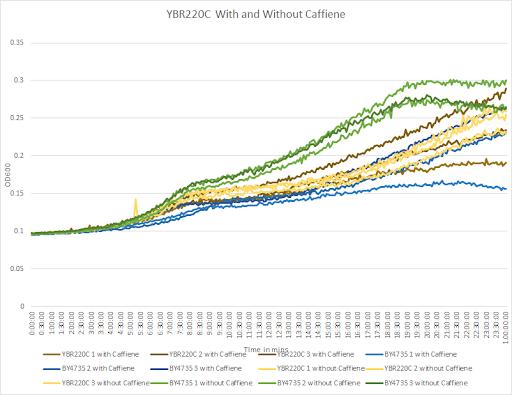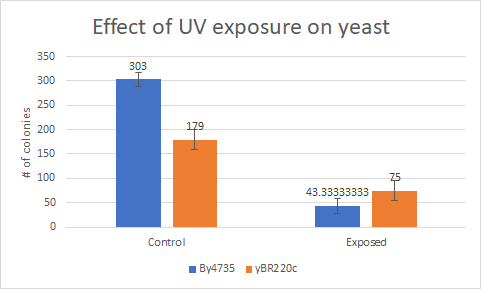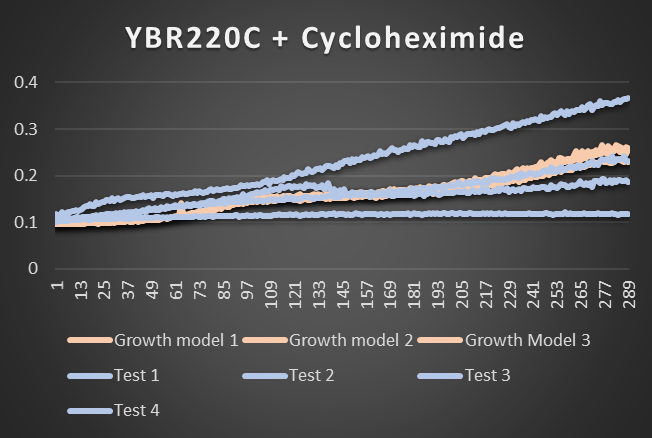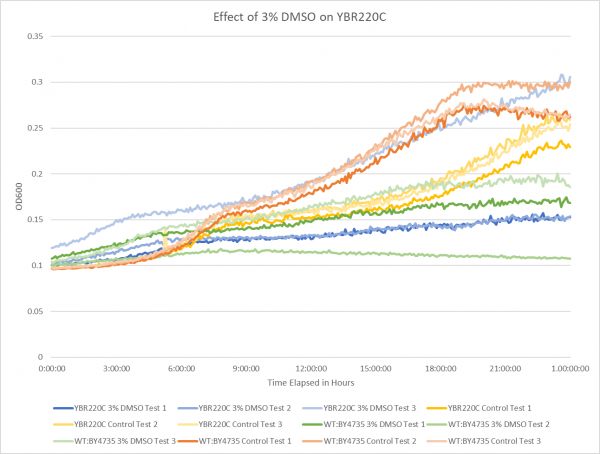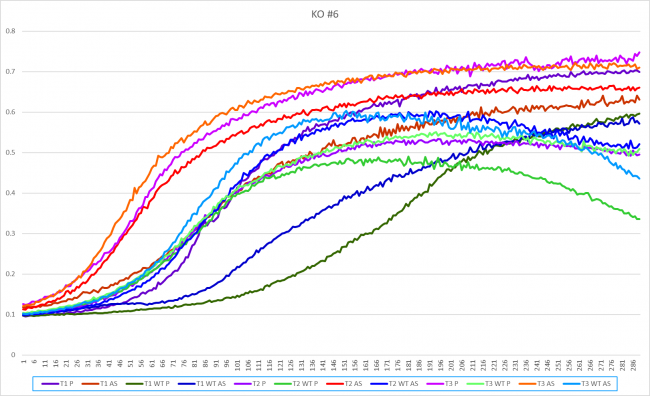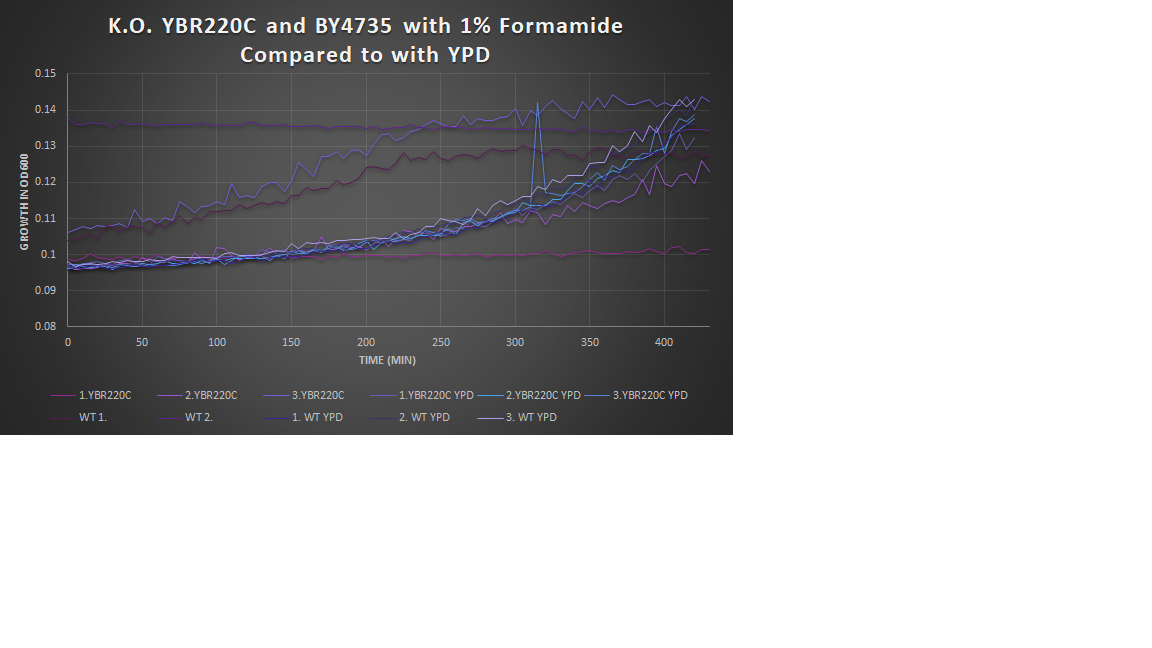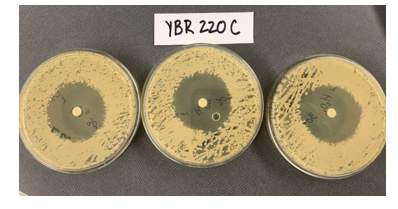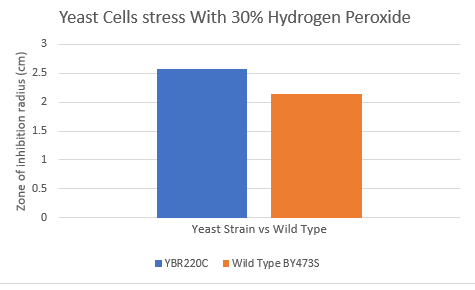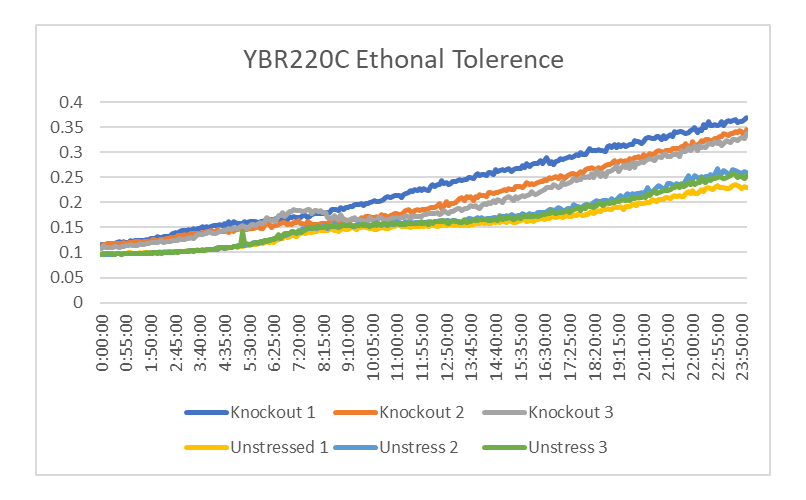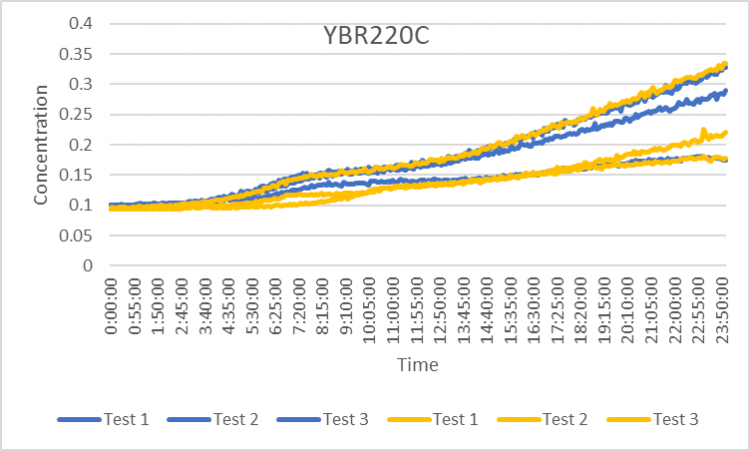YBR220C
Share your knowledge...Edit this entry! <protect>
| Systematic name | YBR220C |
| Gene name | |
| Aliases | |
| Feature type | ORF, Uncharacterized |
| Coordinates | Chr II:664677..662995 |
| Primary SGDID | S000000424 |
Description of YBR220C: Putative protein of unknown function; YBR220C is not an essential gene[1]
</protect>
Contents
Community Commentary
About Community Commentary. Please share your knowledge!
This gene is part of the UW-Stout Orphan Gene Project. Learn more here.
Growth Curve
In a BY4735 background, knocking out YBR220C seems to have a moderate effect on growth rate in log-phase. In this assay, the BY4735 strain's doubling time was 414 minutes, while the YBR220C knock-out strain's doubling time was 457 minutes. (These doubling times are the means of three experiments.)
Caffeine and Yeast Cells
This graph shows the growth curve with and without caffeine. It has the knockout strain and wild type yeast cells. The caffeine enhanced the growth in both wild type and knockout strain. The average doubling time between the three experiments for the knockout strand was 825.71 minutes. The caffeine also had a positive effect on the growth curve for the wild type with the average doubling time being 1245.02 minutes. The results were concluded from the wild type and knockout strand was with this amount of caffeine it leads to an increase in growth.
The protocol can be found at
Caffeine
This bar graph shows that compared to a BY4735 background, Knocking out yBR220c makes yeast less sensitive to UV light exposure
The Protocol can be found at
UV Light Exposure
Cycloheximide effect on YBR220C
Growth models 1-3 are the yeast strands YBR220C not being stressed. And tests 1-4 are the yeast strands being distressed, 1 is low and is not doing well. 2&3 are a little lower than the growth rate. test 4 is much higher than all.
Effect of 3% DMSO on YBR220C
The graph above shows the effect of 3% DMSO on YBR220C. While examining the data from test 3 it is thought that the 3% DMSO test on YBR220C was contaminated; the results are still shown on the graph but the information was not used during growth rate calculations. From the data represented the average doubling rate for the YBR220C knockout strain without DMSO was 652 minutes. When DMSO is added the average doubling time increased to 1019 minutes. This shows that 3% DMSO did add stress to this knockout strain. The average doubling time of WT:BY4735 without DMSO was 514 minutes. The average doubling rate for WT:BY4735 with DMSO was 1529 minutes. If we compare the average doubling rate of WT:BY4735 with DMSO to YBR220C with DMSO we can see that without the YBR220C gene the yeast was able to grow more quickly under DMSO induced stress.
Growth in Proline and Ammonium Sulfate
For YBR220C, when compared to growth in proline media and ammonium sulfate media, this strand grew faster in ammonium sulfate with an average doubling of 37.67 minutes. The average doubling time in the proline media was 41.87. In the wild type strands though, the yeast grew faster in proline media with an average doubling time of 42.2 minutes compared to 50.2 minutes when grown in ammonium sulfate.
1% Formamide Yeast Torture[[1]]
This graph shows the growth curve of the knockout yeast strain YBR220C and wild type BY4735 in 1% formamide in 3 trials. The average calculated doubling time for YBR220C with 1% formamide was 12,783.54 minutes, while the unstressed strain was 3,360.93 minutes. This concluded that the stressed out strain is very sensitive to 1% formamide, and grows at a much slower pace in this environment. Our stressed wild types doubling time was 2,865.53 minutes, and the unstressed was 2,543.42 minutes. The stressed wild type in this experiment proved to show a slight more sensitivity than the unstressed, meaning that addition of 1% formamide for this strain slows down growth.
Zone of Inhibition of 30% Hydrogen Peroxide on YBR220C
The bar graph represents the zone of inhibition of the knockout strain versus the wild type. Our data collected shows that the knockout strain saw a larger zone of inhibition (cells were not able to grow there). Using these observations it is evident that the yeast strain YBR220C undergoes more stress from the oxidative properties of 30 percent hydrogen peroxide. The zone of inhibition is larger because the yeast cells are not able to grow as well as the wild type can in these conditions. For the strain YBR220C our plate values were as follows (in cm) 2.6, 2.6 and 2.45. The calculated mean for these numbers is 2.57 and a standard deviation of 0.08832 compared to our wild type plate which stayed constant 2.1, 2.1 and 2.2 cm
Ethanol Tolerance in YBR220C
This graph shows the growth between YBR220C treated and untreated with ethanol. The rate of growth of the treated yeast is 1132.80 minutes. The rate of growth of the untreated yeast is 1948.28 minutes. This shows that the strands of YBR220C that were treated with ethanol had a decrease rate of growth compared to those that weren't.
Prednisone Effects on YBR220C
The graph above shows how dilutions P2 (30 µg/ml) and E2 (10% ethanol solution) impacted the growth rate of the knockout yeast strain YBR220C over 24 hours. The concentration did not double for test 3 of P2 for this experiment, so by taking only the first two test results, the doubling rate averages to around 1,063 minutes for only ethanol. As for the Prednisone with ethanol, the doubling rate averages to around 923 minutes. Overall, the Prednisone increased the rate of growth by almost 140 minutes. These results conclude that Prednisone slightly promotes the growth of yeast cells without the YBR220C gene.
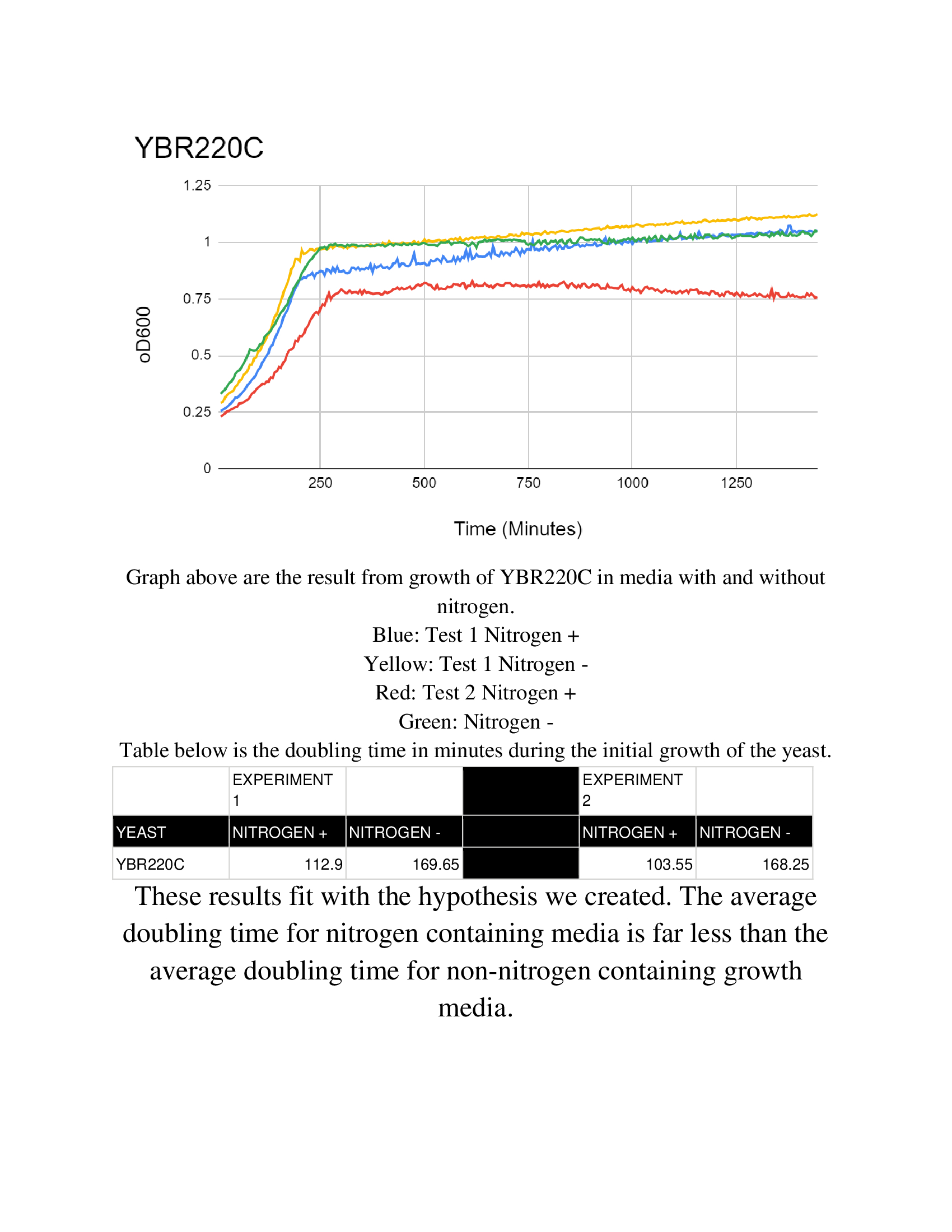
The Wild Type BY4735 has data located at the Nitrogen Starvation Protocol.
Nitrogen starvation
Hydroxyurea
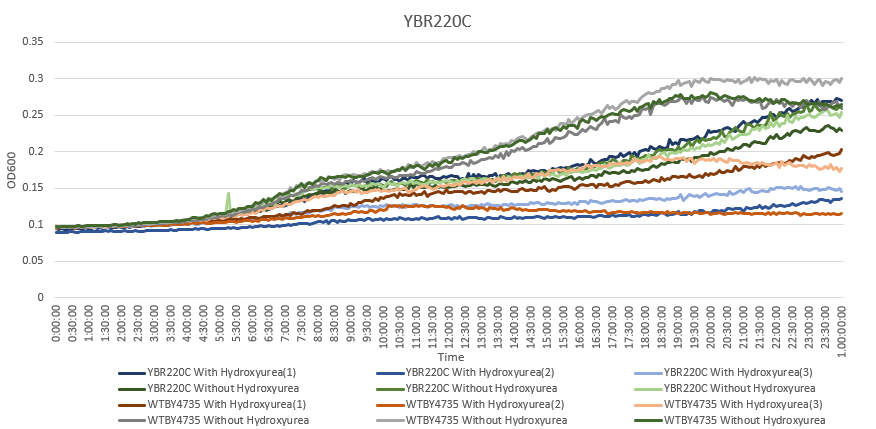 The averaging doubling time for YBR220C is 770.51 minutes. The averaging doubling time for the unstressed YBR220C is 456.36 minutes
The averaging doubling time for YBR220C is 770.51 minutes. The averaging doubling time for the unstressed YBR220C is 456.36 minutes
<protect>
References
See Help:References on how to add references
See Help:Categories on how to add the wiki page for this gene to a Category </protect>
